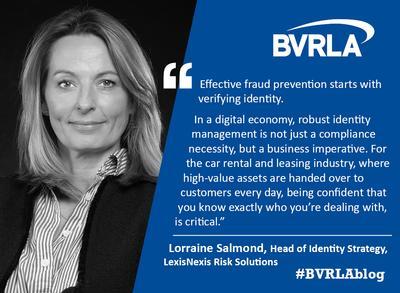Lorraine Salmond, Head of Identity Strategy, UK & Ireland at LexisNexis Risk Solutions talks about effective identity management and the benefits, not only to risk management, but also customer retention.

Effective fraud prevention starts with verifying identity: confirming that your customer is who they claim to be and understanding whether they present a potential risk.
In a digital economy, robust identity management is not just a compliance necessity, but a business imperative. For the car rental and leasing industry, where high-value assets are handed over to customers every day, being confident that you know exactly who you’re dealing with, is critical.
So, what is Identity Management?
An identity is a combination of physical and digital attributes (or characteristics) that belong to a person. A single attribute - such as a name, date of birth, or email address - is usually not enough to distinguish one person from another, but a combination of attributes might be.
Identity management refers to the policies, processes, and technologies used to manage and control the identification, authentication, and authorisation of individuals, ensuring that the right individuals have the appropriate access to the services they need. It includes identification, authentication, and authorisation. The main aim of identity management is to ensure only the real, rightful owners are granted access.
The Business Drivers Behind Identity Management
Strong identity management delivers value across several key areas:
- Customer Onboarding and Retention: You need to onboard legitimate customers quickly and securely and, keep them coming back.
- Customer Experience: In a competitive market, experience can be a real differentiator. Smooth, secure onboarding builds trust and brand loyalty.
- Efficient Risk Management: Staying compliant with regulations while also detecting and mitigating fraud risks is non-negotiable.
Recent research shows that:
- 88% of consumers rank security as their top priority during onboarding.
- 42% abandon the sign-up process due to friction often caused by repeated requests for personal information or sluggish, manual verification steps.
The Four Pillars of Modern Identity Management
To manage identity risk effectively, without creating unnecessary friction, you need a layered, strategic approach. Today’s best practices revolve around four core pillars:
1. Identity Verification
This step checks whether the claimed identity exists and can be trusted. It’s typically data-driven, relying on authoritative sources such as Electoral Roll, Death Register and Credit Reference Agenices, to answer questions like:
- Does this identity exist and has it existed over time?
- Is the identity currently active or valid?
2. Identity Authentication
This verifies that the person presenting the identity is genuinely its rightful owner. Techniques can include:
- Document checks
- Biometric verification
- One-Time Passwords (OTP)
Re-authentication is also vital to prevent account takeover, a growing fraud vector in digital services.
3. Identity Risk Assessment
Beyond confirming identity, you need to evaluate risk factors such as:
- Digital signals: Whether an email or device has been linked to previous fraud
- Location anomalies: Such as a UK applicant using a device located overseas
- Sanctions and Politically Exposed Person (PEP) screenings
- Synthetic identities: Constructed using real and fake information to bypass verification
4. Orchestration
Managing all these checks manually is complex and prone to gaps. That’s where orchestration comes in.
Identity orchestration unifies all risk signals, verification steps and compliance checks into a seamless process, giving you a holistic view of customer risk. This enables faster decisions, less friction, and smarter fraud prevention.
LexisNexis® IDU® provides an accurate seamless, digital-first identity verification process that combines authoritative data sources with document validation and biometric checks. This ensures that the person presenting the identity is not only real, but truly who they claim to be. It verifies identity attributes against trusted databases, including electoral roll and credit reference agencies – with the ability to scan identity documents like driving licences and passports for authenticity. The configurability of IDU® and the depth and breadth of data it can check against means that it can be tailored according to your specific risk appetite and the optimum point in your existing customer journey.
LexisNexis IDU is certified under the UK Government’s; Digital Identity and Attributes Trust Framework aligning with the UK Government Good Practice Guide 45 (GPG45) standards.




